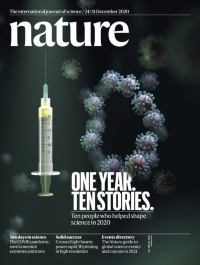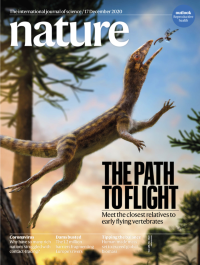Volume 588
-
No. 7839 24 December 2020
One year. Ten stories.As this difficult year draws to a close, we look back at the past 12 months through the lens of Nature’s 10 — ten people who helped to shape science during 2020. Perhaps unsurprisingly, the cover image reflects the biggest story of the year: the COVID-19 pandemic and the hunt for a vaccine. With the global effort to understand and combat the virus resulting in candidate vaccines gaining approval with unprecedented speed, there are hopes that the needle will help free the world from the grip of SARS-CoV-2.
-
No. 7838 17 December 2020
The path to flightPterosaurs were the first vertebrates to evolve powered flight, but tracing their exact evolutionary origins has proved to be difficult. In this week’s issue, Martin Ezcurra and his colleagues help to plug that gap by showing that a group of long-limbed, gracile creatures called lagerpetids, such as Ixalerpeton polesinensis shown in an artist’s impression on the cover, are very likely to be the sister group of pterosaurs. Using micro-computed tomography scans and 3D reconstructions of skeletal remains, the researchers were able to identify unique features, such as the shape of the inner ear, that lagerpetids share with pterosaurs. Although the exact transition between land-dwelling and flying vertebrates remains unknown, the evidence collected by the team illuminates the first steps towards the anatomical characteristics of the pterosaurs.
Focal Point
-
No. 7837 10 December 2020
Mapping metastasisMost deaths from cancer are related to tumours spreading to secondary sites in the body through metastasis, yet there are significant gaps in our knowledge of the underlying biology of this process. In this week’s issue Todd Golub and his colleagues report the MetMap, a barcoding system that they have used to determine the metastatic potential of human cancer cell lines. The system is based on an analysis of some 500 cell lines representing 21 solid cancer types. From their analyses, the researchers created petal plots, as illustrated on the cover, that relate to the metastatic pattern of the cancer cells. The team used the map to assess breast cancers that metastasize to the brain, finding that this process was linked to changes in lipid metabolism that could be a target for future therapies.
Nature Index
-
No. 7836 3 December 2020
Turning back timeAgeing is a degenerative process that leads to tissue dysfunction and death. At a molecular level, disruption to patterns of gene expression caused by the accumulation of epigenetic ‘noise’ has been suggested as a potential mechanism for the decline in tissue function. In this week’s issue, David Sinclair and his colleagues report that expression of three Yamanaka transcription factors in ganglion retina cells reprograms them to a more youthful epigenetic state and turns back the clock for nerve cells in the eye. The researchers found that the transcription factors restored youthful DNA methylation patterns and transcriptomes in the tissue. As a result, mice with damaged optic nerves were able to regrow axons, and vision loss was reversed in a mouse model of glaucoma and in old mice. The team found that enzymes that remove DNA methylation were required to repair eyesight. These results show that mammalian tissues retain a record of youthful information, encoded in part by DNA methylation, which can be accessed to improve tissue function and potentially to reverse the effects of ageing.
Nature Outlook




